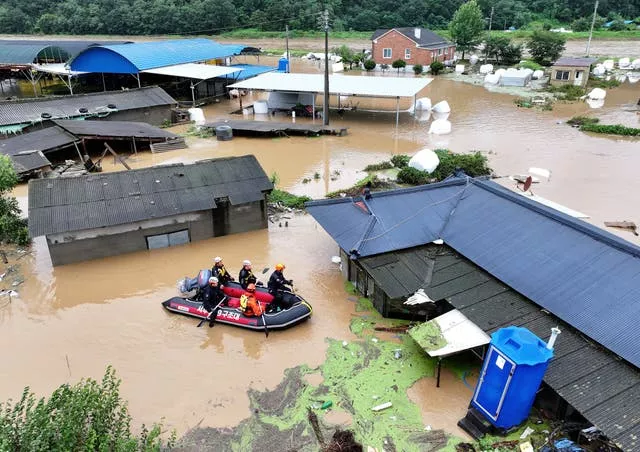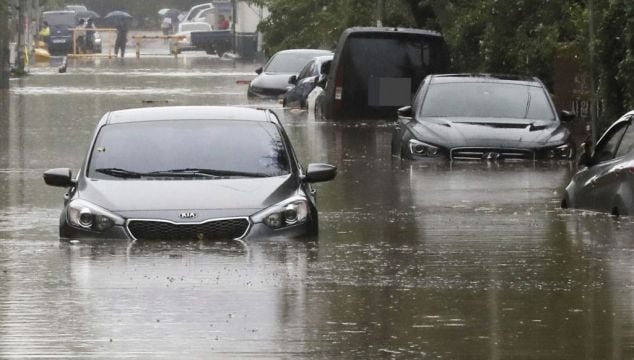At least one person died on Thursday as tropical storm Khanun moved north towards major urban centres near Seoul.
More than a foot of rain fell in eastern and southern areas after the storm made landfall on the mainland in the morning. Emergency workers responded to increasing reports of flooding and landslides by the afternoon.
More than 16,000 people, mostly in southern regions, were evacuated from their homes as emergency workers responded to landslides, flood-damaged homes and rising rivers and streams. More than 40,000 homes were without power.

Officials shut down hundreds of roads, streets and public parks and sent text alerts warning about the perils posed by Khanun, which is hitting South Korea weeks after torrential rains caused flash floods and landslides that killed at least 47 people.
After making landfall at around 9.20am near the south-eastern port city of Geoje, Khanun had passed central South Korea as of Thursday evening and was heading towards the densely populated Seoul metropolitan area, where half of the country’s 51 million people live.
The storm delivered heavy rain as it slowly ploughed toward the capital, its strength diminished as it moved inland. Khanun was generating maximum wind speeds of 45mph, compared to around 80mph at the point of landfall.
The storm was expected to move into North Korea early on Friday, but forecasters said the greater Seoul area would still feel its force until Friday afternoon.
Among the areas of South Korea hardest hit by Khanun was the southern inland city of Daegu, where rescue workers navigated a submerged village in rubber boats, looking for residents who might have been left behind.
A 67-year-old man who was found unconscious near a bloated stream was later pronounced dead at a hospital, according to Lee Ga-yeon, an official at the Daegu fire department. The city’s emergency workers were searching for another person who got swept into a stream while using a wheelchair.
In Gangwon province, a mountainous region on the east coast where the Korea Meteorological Administration forecast 20 to 23 inches of rain in some places, emergency workers in the seaside cities of Gangneung and Sokcho waded across rivers of brown, thigh-high water covering what used to be streets.

In nearby Yangyang county, workers repaired the embankment of another stream that crumbled and was spilling water on a major highway.
In the southern city of Changwon, emergency workers used ropes to rescue pedestrians trapped in huge zones of flooded roads and responded to landslides that spilled dirt and other debris over motorways. Residents and shop owners blocked their doors with sandbags while workers established flood shields to protect a major seafood market.
In Geoje, emergency workers in helmets examined a car park where vehicles were smashed or damaged by bricks and other debris apparently flown by forceful winds.
In coastal Busan, South Korea’s second-largest city, several motorways were closed because of flooding. Emergency workers cleared uprooted trees that collapsed over roads and responded to destroyed walls and fences, broken windows, and other damage. A public park in the Yeonje district was submerged.
The neighboring cities and towns of Gimhae, Ulsan, Pohang, Gimcheon issued flood warnings for areas near rivers and streams that flow through its urban districts.
At least 51 roads and 17 homes and buildings were destroyed or damaged by floods, the Ministry of the Interior and Safety said.
More than 620 motorways were shut down, more than 380 flights were grounded and nearly 1,600 schools closed nationwide, according to the safety ministry and aviation authorities. Hundreds of trains were cancelled, ferry services were fully halted, and more than 60,000 fishing vessels sent to port.
In North Korea, state media described nationwide efforts to strengthen the monitoring of roads, railways, bridges and coastlines, and to employ measures to protect factory machines and crops.







